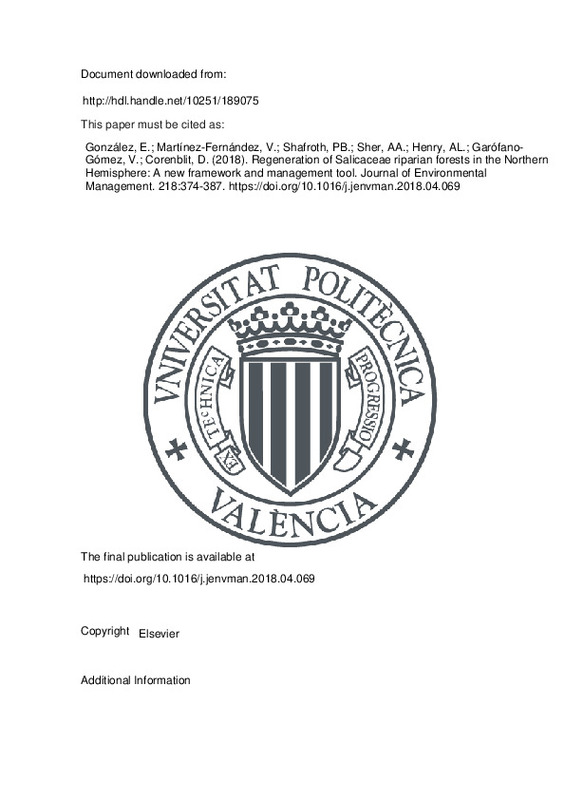JavaScript is disabled for your browser. Some features of this site may not work without it.
Buscar en RiuNet
Listar
Mi cuenta
Estadísticas
Ayuda RiuNet
Admin. UPV
Regeneration of Salicaceae riparian forests in the Northern Hemisphere: A new framework and management tool
Mostrar el registro sencillo del ítem
Ficheros en el ítem
| dc.contributor.author | González, Eduardo
|
es_ES |
| dc.contributor.author | Martínez-Fernández, Vanesa
|
es_ES |
| dc.contributor.author | Shafroth, Patrick B
|
es_ES |
| dc.contributor.author | Sher, Anna A
|
es_ES |
| dc.contributor.author | Henry, Annie L
|
es_ES |
| dc.contributor.author | Garófano-Gómez, Virginia
|
es_ES |
| dc.contributor.author | Corenblit, Dov
|
es_ES |
| dc.date.accessioned | 2022-11-03T10:38:14Z | |
| dc.date.available | 2022-11-03T10:38:14Z | |
| dc.date.issued | 2018-07-15 | es_ES |
| dc.identifier.issn | 0301-4797 | es_ES |
| dc.identifier.uri | http://hdl.handle.net/10251/189075 | |
| dc.description.abstract | [EN] Human activities on floodplains have severely disrupted the regeneration of foundation riparian shrub and tree species of the Salicaceae family (Populus and Salix spp.) throughout the Northern Hemisphere. Restoration ecologists initially tackled this problem from a terrestrial perspective that emphasized planting. More recently, floodplain restoration activities have embraced an aquatic perspective, inspired by the expanding practice of managing river flows to improve river health (environmental flows). However, riparian Salicaceae species occupy floodplain and riparian areas, which lie at the interface of both terrestrial and aquatic ecosystems along watercourses. Thus, their regeneration depends on a complex interaction of hydrologic and geomorphic processes that have shaped key life-cycle requirements for seedling establishment. Ultimately, restoration needs to integrate these concepts to succeed. However, while regeneration of Salicaceae is now reasonably well-understood, the literature reporting restoration actions on Salicaceae regeneration is sparse, and a specific theoretical framework is still missing. Here, we have reviewed 105 peer-reviewed published experiences in restoration of Salicaceae forests, including 91 projects in 10 world regions, to construct a decision tree to inform restoration planning through explicit links between the well-studied biophysical requirements of Salicaceae regeneration and 17 specific restoration actions, the most popular being planting (in 55% of the projects), land contouring (30%), removal of competing vegetation (30%), site selection (26%), and irrigation (24%). We also identified research gaps related to Salicaceae forest restoration and discuss alternative, innovative and feasible approaches that incorporate the human component. | es_ES |
| dc.description.sponsorship | EG's participation in this work was partially supported by a Marie Curie International Outgoing Fellowship within the 7th European Community Framework Programme (ESFFORES project grant number 299044). VMF was supported by a pre-doctoral program from the Ministerio de Educacion, Cultura y Deporte, Spain, FPU 2013. PBS and EG were partially supported by the U.S. Geological Survey, Invasive Species Program. We thank M. Grabau and three anonymous reviewers for helpful comments on earlier drafts of the manuscript. Any use of trade, firm, or product names is for descriptive purposes only and does not imply endorsement by the U.S. Government. | es_ES |
| dc.language | Inglés | es_ES |
| dc.publisher | Elsevier | es_ES |
| dc.relation.ispartof | Journal of Environmental Management | es_ES |
| dc.rights | Reconocimiento - No comercial - Sin obra derivada (by-nc-nd) | es_ES |
| dc.subject | Cottonwood | es_ES |
| dc.subject | Decision tree | es_ES |
| dc.subject | Environmental flow | es_ES |
| dc.subject | Poplar | es_ES |
| dc.subject | Riparian forest | es_ES |
| dc.subject | Willow | es_ES |
| dc.title | Regeneration of Salicaceae riparian forests in the Northern Hemisphere: A new framework and management tool | es_ES |
| dc.type | Artículo | es_ES |
| dc.identifier.doi | 10.1016/j.jenvman.2018.04.069 | es_ES |
| dc.relation.projectID | info:eu-repo/grantAgreement/EC/FP7/299044/EU | es_ES |
| dc.rights.accessRights | Abierto | es_ES |
| dc.contributor.affiliation | Universitat Politècnica de València. Instituto de Investigación para la Gestión Integral de Zonas Costeras - Institut d'Investigació per a la Gestió Integral de Zones Costaneres | es_ES |
| dc.contributor.affiliation | Universitat Politècnica de València. Instituto de Investigación para la Gestión Integrada de Zonas Costeras - Institut d'Investigació per a la Gestió Integrada de Zones Costaneres | es_ES |
| dc.description.bibliographicCitation | González, E.; Martínez-Fernández, V.; Shafroth, PB.; Sher, AA.; Henry, AL.; Garófano-Gómez, V.; Corenblit, D. (2018). Regeneration of Salicaceae riparian forests in the Northern Hemisphere: A new framework and management tool. Journal of Environmental Management. 218:374-387. https://doi.org/10.1016/j.jenvman.2018.04.069 | es_ES |
| dc.description.accrualMethod | S | es_ES |
| dc.relation.publisherversion | https://doi.org/10.1016/j.jenvman.2018.04.069 | es_ES |
| dc.description.upvformatpinicio | 374 | es_ES |
| dc.description.upvformatpfin | 387 | es_ES |
| dc.type.version | info:eu-repo/semantics/publishedVersion | es_ES |
| dc.description.volume | 218 | es_ES |
| dc.identifier.pmid | 29704833 | es_ES |
| dc.relation.pasarela | S\462143 | es_ES |
| dc.contributor.funder | European Commission | es_ES |







![[Cerrado]](/themes/UPV/images/candado.png)

